India consumes the most lentils of all nations; they are a staple food in that country. India also has hundreds of millions of vegetarians. In the US, eating dead animal parts is quite common — vegetarian and vegan diets are not nearly as popular. Many Americans appear to assume that plant foods are lacking protein and that the ‘quality’ of plant protein is deficient. Neither assumptions are true.
Looking at the United States Department of Agriculture’s website, FoodData Central, it is clear lentils have far more protein than some people might expect.
For a portion size of 100 grams, dry lentils have 23.6 grams of protein, with only 1.92 grams of fat. In case you are wondering, 100 grams is about 3.5 ounces. They also have 949 milligrams of potassium, a significant electrolyte. Iron, zinc, magnesium, manganese, copper and calcium are present as well, among other nutrients.
How much protein is in 100 grams of hamburger? The same food and nutrition website referenced above does not mention hamburger; it does mention ‘Beef, ground, 80% lean meat / 20% fat, raw’. The amount of protein is 17.5 grams for the same portion size as the lentils. The lentils have about 6 grams more protein for that portion size. The ground beef has 19.2 grams of fat — about 10 times more than the lentils. The ground beef has far less potassium and it contains both sodium and cholesterol. The lentils have almost no sodium and no cholesterol.
Some people might say lentils don’t have all 9 essential amino acids, but they actually do. They are lower in the amino acid Methionine than some foods, but they are not entirely missing it. So, lentils can be combined with plant foods that contain more Methionine to bolster the presence of that amino acid. Beans, nuts, seeds, quinoa, green peas, succotash, sweet potatoes, and buckwheat are examples of some foods to consume with lentils.
CleanTechnica is a sustainability website and is mostly not about food. However, human food choices do matter for climate change. Lentils are one of the lower or lowest-carbon foods. Beef is the highest or one of the highest carbon foods. If you want to reduce your contribution to climate change and climate change impacts, it may be beneficial to consider reducing or eliminating beef as a food source.
Americans are the top beef-eating country people in the world, according to various sources. “It’s pretty much universal across the peer reviewed scientific literature that we urgently need to curb agricultural greenhouse gas emissions to avoid the most catastrophic climate change scenarios. One of the biggest and fastest ways we can achieve that is by cutting back on the amount of beef and milk that is produced.”
We Americans are not trying to deliberately contribute to climate change by eating so much beef — the situation is not one born of malice. It appears to be a mix of ignorance and denial.
Sign up for CleanTechnica’s Weekly Substack for Zach and Scott’s in-depth analyses and high level summaries, sign up for our daily newsletter, and follow us on Google News!
Advertisement
Have a tip for CleanTechnica? Want to advertise? Want to suggest a guest for our CleanTech Talk podcast? Contact us here.
Sign up for our daily newsletter for 15 new cleantech stories a day. Or sign up for our weekly one on top stories of the week if daily is too frequent.
CleanTechnica uses affiliate links. See our policy here.
CleanTechnica’s Comment Policy

